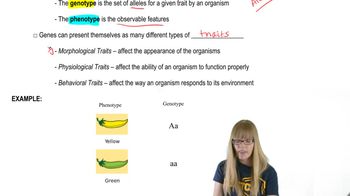Payne, B. A. et al. (2013) present evidence that a low level of heteroplasmic mtDNA exists in all tested healthy individuals.
What genetic conditions within a given mitochondrion are likely to contribute to such a variable pool of mitochondria?
Ch. 9 - Extranuclear Inheritance
Chapter 9, Problem 22
Because offspring inherit the mitochondrial genome only from the mother, evolutionarily the mitochondrial genome in males encounters a dead end. The mitochondrial genome in males has no significant impact on the genetic information of future generations. Scientists have proposed that this can result in an accumulation of mutations that have a negative impact on genetic fitness of males but not females. Experiments with Drosophila support this possibility. What experimental data or evidence would you want to evaluate or consider to determine if an accumulation of mtDNA mutations negatively impacts the fitness of males of any species?
 Verified step by step guidance
Verified step by step guidance1
span>Identify the specific traits or fitness indicators in males that could be affected by mitochondrial DNA (mtDNA) mutations. This could include traits like lifespan, reproductive success, or physical performance.</span
span>Design an experiment to compare these traits between males with normal mtDNA and those with accumulated mutations. This could involve creating a controlled environment where mtDNA mutations are introduced or naturally occur over generations.</span
span>Collect and analyze data on the identified traits from both groups of males. Use statistical methods to determine if there are significant differences in fitness indicators between the two groups.</span
span>Consider the role of nuclear DNA in compensating for mtDNA mutations. Evaluate if males with certain nuclear genetic backgrounds are more or less affected by mtDNA mutations.</span
span>Review existing literature on similar studies in Drosophila or other species to compare findings and strengthen the conclusions about the impact of mtDNA mutations on male fitness.</span

Verified Solution
Video duration:
1mWas this helpful?
Key Concepts
Here are the essential concepts you must grasp in order to answer the question correctly.
Mitochondrial Inheritance
Mitochondrial inheritance refers to the transmission of mitochondrial DNA (mtDNA) exclusively from the mother to her offspring. This unique inheritance pattern means that males do not pass on their mtDNA, leading to a situation where any mutations in their mitochondrial genome do not affect future generations. Understanding this concept is crucial for analyzing how mtDNA mutations can accumulate in males without being purged through natural selection.
Recommended video:
Guided course

Organelle Inheritance
Genetic Fitness
Genetic fitness is a measure of an organism's ability to survive and reproduce in its environment, contributing to the gene pool of future generations. In the context of mtDNA mutations, a decrease in genetic fitness can occur if these mutations impair cellular functions, leading to reduced survival or reproductive success. Evaluating the impact of mtDNA mutations on male fitness is essential for understanding their evolutionary consequences.
Recommended video:
Guided course

Descriptive Genetics
Experimental Evidence in Drosophila
Drosophila, or fruit flies, are commonly used in genetic research due to their short life cycles and well-mapped genomes. Experiments involving Drosophila can provide insights into how mtDNA mutations affect fitness by comparing the reproductive success and survival rates of males with varying levels of mtDNA mutations. Analyzing such data can help determine if there is a correlation between mtDNA mutation accumulation and male fitness, supporting or refuting the proposed hypothesis.
Recommended video:
Guided course

Drosophila P Element
Related Practice
Textbook Question
245
views
Textbook Question
Payne, B. A. et al. (2013) present evidence that a low level of heteroplasmic mtDNA exists in all tested healthy individuals.
What are two likely sources of such heteroplasmy?
195
views
Textbook Question
As mentioned in Section 9.3, mtDNA accumulates mutations at a rate approximately ten times faster than nuclear DNA. Thus geneticists can use mtDNA variations as a 'molecular clock' to study genetic variation and the movement of ancestral human populations from Africa to different areas of the world more than 125,000 years ago. Propose an explanation for how an analysis of mtDNA can be used to construct family trees of human evolution.
237
views
